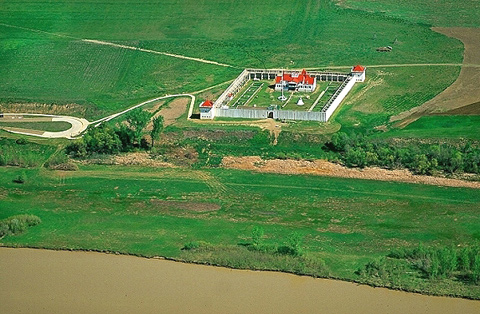On 26 April 1805 strong winds and blowing sand again impeded the main party, but they still managed to cover eight miles before dark. Meanwhile, Lewis and a small party, traveling half a day ahead of the others, explored the Missouri River on foot, looking for a suitable trading-post site. The north side opposite the mouth of the Yellowstone was, Lewis observed, twelve to eighteen feet above water level, less likely to be flooded by these “capricious and versatile” rivers, “except in extreme high water, which dose not appear to be very frequent.” And that is where, in 1828, John Jacob Astor’s American Fur Company—one of the first corporate monopolies in American business history—built Fort Union, which remained the axis of Indian-American commerce on the Upper Missouri until the late 1860s.
Manpowered boats somewhat like the ones the Corps of Discovery used continued to inch up the Missouri for decades (for examples, see Post-Expedition Fur Trade), until the first steamboat, the Yellow Stone, reached Fort Union in 1832. By the 1840s, travel time from St. Louis to Fort Union had shrunk to a record-breaking, breathtaking forty-eight days and seven hours. The keelboat era soon became but a memory—no doubt a painful one for all the men who had waded up the mighty, muddy river, dragging tons of dead weight against the current, continually fighting the river’s natural tendency to fling them back and sink their boats.
This photograph shows the National Park Service’s reconstruction of historic Fort Union. The parking lot would scarcely have been adequate for the crowds of Mandans, Hidatsas, Assiniboines, Blackfeet, Crows, and others who camped near its riverfront gate or grazed their ponies on the vast prairie to the north.
From Discovering Lewis & Clark from the Air
Photography by Jim Wark
Text by Joseph Mussulman
Reproduced by permission of Mountain Press
Experience the Lewis and Clark Trail
The Lewis and Clark Trail Experience—our sister site at lewisandclark.travel—connects the world to people and places on the Lewis and Clark Trail.
Discover More
- The Lewis and Clark Expedition: Day by Day by Gary E. Moulton (University of Nebraska Press, 2018). The story in prose, 14 May 1804–23 September 1806.
- The Lewis and Clark Journals: An American Epic of Discovery (abridged) by Gary E. Moulton (University of Nebraska Press, 2003). Selected journal excerpts, 14 May 1804–23 September 1806.
- The Lewis and Clark Journals. by Gary E. Moulton (University of Nebraska Press, 1983–2001). The complete story in 13 volumes.


